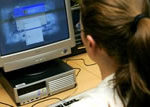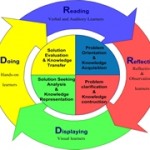
(Editor’s note: This article was written with college-level instructors in mind, but it’s just as applicable to secondary-school classrooms.)
“We’re doomed.” –C3PO to R2-D2
Frustrated. Challenged. Excited. Passionate. Overwhelmed. Opportunities. Waiting. These are the things I hear when I ask college professors around the world for two or three words to describe the use of web technologies in their classes. It does not matter if I am in Thailand, Taiwan, or Transylvania: I hear the same words. Many view technology as simultaneously a transformative tool for teaching and learning and one that should be avoided where possible. That is not surprising, given the barrage of new technologies to consider since the start of the millennium–including wikibooks, podcasting, Twitter, Second Life, digital books, open educational resources, shared online video, Facebook, and much more.
During the past two decades, I have designed several models and frameworks to help college professors sort through their options. The Read, Reflect, Display, and Do (R2D2) model is one such framework. While some look at it as a learning-style model, it is intended as a problem-solving wheel that represents phases of learning–from reading and exploration, to reflective writing, to visualization of the content learned, to attempts to try it out. R2D2 is also a means to help instructors consider diverse learner needs. At its core, it is also a tool for reflecting on one’s teaching practices. The four phases are described below.
Phase One: Read
The web contains countless resources for reading, researching, and listening. You can have your students discover and read online articles from open-access journals, expert web sites, or online portals of famous scientists like Albert Einstein, Jane Goodall, or Charles Darwin or writers like William Shakespeare, Jane Austen, or Edgar Allan Poe. There are tens of millions of online documents to read, discuss, debate, juxtapose, connect, compare and contrast, and perhaps turn into something totally different. Your students might also download and read scores of free eBooks made available by Google, the Internet Archive, ManyBooks.net, Bookyards, and others. Instead of reading from experts, students also might listen to podcasts that relate to course content. Some professors are currently pushing the edges of the risk continuum in this phase of the R2D2 model by using Twitter as a teaching tool. For example, students might be assigned to track the activities of a world-famous person who tweets.
Phase Two: Reflect
A natural next step is for students to blog about the concepts or ideas that they learned from their reading or listening activities. Such blogging might be done individually or in teams. Critical friends within the class or experts outside it might provide feedback on their blog posts. Your students might also read or track the blog posts of experts that relate to the topic of a class or program of studies. To push beyond the instructor as the sole source of knowledge, they might watch and reflect upon keynote speeches and the teachings of other participants from online conferences. Your students might also reflect on cases or scenarios that are posted online.
Phase Three: Display
The third phase involves pictures, timelines, flow charts, diagrams, and films. Such resources can now be found online in nearly any discipline. There are timelines of U.S. presidents, flash animations of cash flow principles, simulations of chemistry experiments, or stunning overviews of statistical procedures. Pubcasts from SciVee bring your students into the world of scientists. They can see and hear from the people who wrote the articles they have read. Shared online videos posted to YouTube, TeacherTube, FORA.tv, Link TV, CNN Video, Google Videos, NASA TV, TV Lesson, and other such places provide tremendous video content to help clarify or explain key course concepts or principles in visual ways. Medical animations in YouTube or Second Life can add to such visual richness. Using such online video content can anchor instruction in content that students can rewatch many times. The web also allows for knowledge mapping of key concepts using free tools like Gliffy, Bubbl.us, Mindomo, or MindMeister. Digital libraries and museums like the new United Nations World Digital Library and the Civil Rights Digital Library provide thousands of pictures, diagrams, and other visual images that students can explore. There is no shortage of visual content today, and it will only increase. Ten years from now, visual content may represent the bulk of course resources.
Phase Four: Do
The internet provides many paths to try out course content in a safe harbor. Your students can perform plays in Second Life. They can practice their language skills in Mixxer, Babbel, KanTalk, or Livemocha. They can collect survey or polling data with dozens of different tools and collaboratively analyze and share their results using Google Docs. Similarly, real-world data from corporations or nonprofit organizations might be analyzed and reports generated. Beyond simple reports or term papers, they might also compose their own books in Wikibooks or create class projects such as a glossary in a wiki (e.g., PBworks or Wikispaces). Students might also produce their own podcasts or podcast series or YouTube-like videos related to course content. They can also solve problems or simulations online.
“R2-D2, where are you?” –C3PO
The figure below depicts the R2D2 model. To use the model, you do not have to go in order of each phase or use them all. While the arrows indicate direction in the use of the model, online activities could actually cycle in the opposite direction.

“R2-D2, it is you, it is you!” –C3PO to R2-D2
Hopefully, you can use this model or something similar. You might even recognize it in your own teaching. Without models, frameworks, and guidelines, instructors utilizing the web for learning will continue to be overwhelmed, frustrated, and perhaps feel that they are doomed.
“Excuse me sir, but that R2-D2 is in prime condition, a real bargain.” –C3PO to Luke
R2D2 is one pedagogical approach for web tools and resources. One model. One idea. I have personally witnessed wonderful results from Singapore to Spain to Saudi Arabia. Perhaps you can, too.
Curtis J. Bonk is Professor of Instructional Systems Technology at Indiana University. He has a popular blog called TravelinEdMan and is the author of The World Is Open: How Web Technology Is Revolutionizing Education; Empowering Online Learning: 100+ Ideas, for Reading, Reflecting, Displaying, and Doing; and The Handbook of Blended Learning: Global Perspectives, Local Designs.
Bonk, C. J. (July 2009). The World is Open: How Web Technology is Revolutionizing Education. San Francisco, CA: Jossey-Bass, a Wiley imprint. (Book home page: http://worldisopen.com/)
Bonk, C. J., & Zhang, K. (2008). Empowering Online Learning: 100+ Activities for Reading, Reflecting, Displaying, and Doing. San Francisco, CA: Jossey-Bass.
Links:
Complete Works of Charles Darwin Online
The Complete Works of William Shakespeare
Edgar Allan Poe Society of Baltimore
United Nations World Digital Library
- Friday 5: Universal Design for Learning - April 19, 2024
- Educators love their edtech, but want more training - April 18, 2024
- Friday 5: College and career readiness - April 12, 2024

